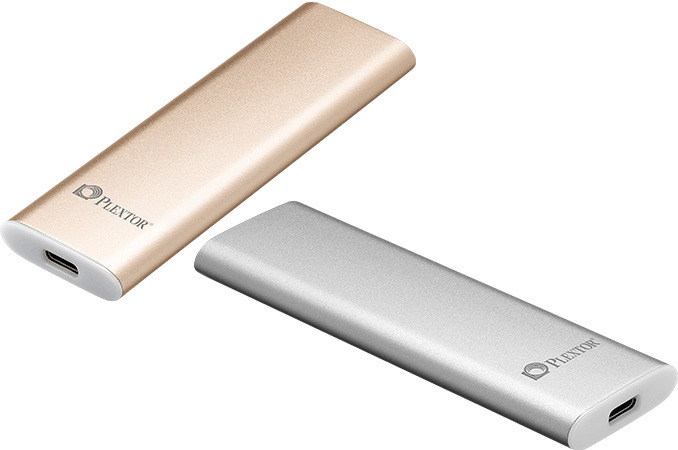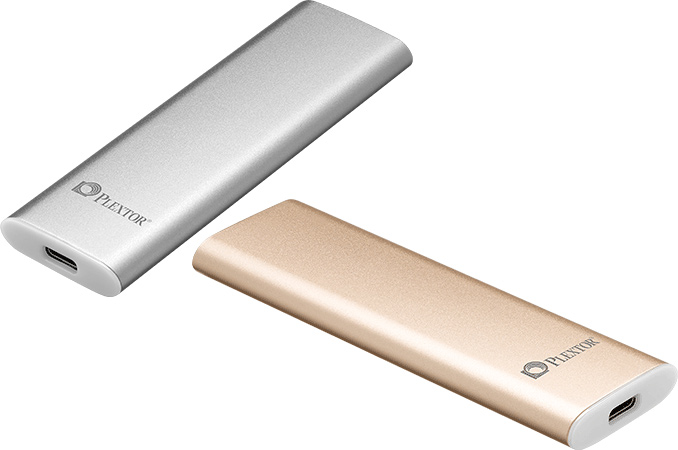Plextor Launches EX1 USB-C External SSD: Up to 550 MBps, 512 GB and LDPC
by Anton Shilov on November 22, 2016 12:40 PM EST
Plextor this week formally launched its first external SSD which it demonstrated back in early June at Computex. The Plextor EX1 combines low weight, high capacity, a high quoted performance with a USB 3.1 Type-C interface. Moreover, the manufacturer promises increased endurance as well as reliability due to an advanced SSD controller and even offers the drive with a five-year warranty.
As reported initially, the Plextor EX1 SSDs will be available in 128 GB, 256 GB and 512 GB configurations. The drives will use USB 3.1 Gen2 Type-C interface with up to 10 Gb/s transfer rate and thus will be compatible with both currently available (via USB-C to USB-A adapter) and upcoming PCs. Since the EX1 is a fully-fledged SSD, not a flash drive, the compatibility with future systems was a requirement in the product design. Moreover, to emphasize that this is not a USB stick, the EX1 has a USB-C receptacle rather than a connector, which means that owners will have to use a cable to plug the drive into their systems (not very comfortable, but ensures that nothing accidentally breaks down as a result of careless usages).
Plextor does not reveal a lot of details about the product, but claims that it uses a Marvell controller that supports LDPC error correction technology as well as PlexNitro feature (both technologies are used by Plextor in their TLC NAND-based drives), a VIA Labs VL716 USB 3.1-to-SATA bridge as well as Toshiba’s TLC NAND made using a 15 nm process. Since Plextor already has a working SSD platform featuring the Marvell 88SS1074B1 controller and Toshiba’s 15 nm TLC NAND (used in its M7V drives), it is highly likely that this platform served as the base for the EX1 as well. On the other hand, the EX1 has a longer warranty, but the same 1.5 million hours MTBF rating and similar general performance specs.
Speaking of performance, Plextor claims that the EX1 is capable of up to 550 MB/s read speed as well as up to 500 MB/s write speed (obviously, when pseudo-SLC caching is used), which is in line with performance of the M7V SSDs and is faster than declared transfer rate of the Samsung Portable T3 SSD (yet, this one has considerably higher capacity). Nonetheless, keep in mind that the real-world performance of SSDs is typically lower than that specified.
| Plextor M7V and M6V SSD Specifications | ||||
| Size | 128 GB | 256 GB | 512 GB | |
| Controller | Marvell 88SS1074B1 (?) | |||
| NAND | Toshiba 15 nm Toggle TLC | |||
| DRAM Cache | 256 MB (?) | 512 MB (?) | 1 GB (?) | |
| Sequential Read | 550 MB/s | |||
| Sequential Write | 500 MB/s | |||
| Interface | Physical | USB Type-C receptacle | ||
| Logical | USB 3.1 Gen 2 | |||
| Transfer Rate | 10 Gbps | |||
| Compatibility | Backwards compatible with previous-gen USB standards and connectors using adapters |
|||
| Command Set | TRIM, S.M.A.R.T., NCQ, ATA/ATAPI-8 | |||
| OS Compatibility | Apple macOS, Google Android, Microsoft Windows, Linux | |||
| Security | Fnet encryption software | |||
| Dimensions | 101.2 × 31.6 × 8.7 mm 3.98 × 1.24 × 0.34 inches |
|||
| Weight | 30 grams | |||
| Apparance | Silver color and Gold color enclosure made of anodized aluminum | |||
| Accessories | USB 3.1 Type-C to Type-A cable Flannel Bag |
|||
| Warranty | 5 years | |||
When it comes to features, the Plextor EX1 looks just like a typical SSD drive for desktop computers: it supports TRIM, NCQ, SMART features and relies on the ATA/ATAPI-8 protocol. The drive is compatible with Microsoft Windows, Google Android, Apple macOS and Linux, but with certain limitations imposed by different file systems. For example, Android only supports exFAT and FAT32, but not NTFS, whereas FAT32 does not support files larger than 4 GB. Meanwhile, exFAT is not supported by Linux.
The Plextor EX1 drives come in gold and silver colored enclosures made of anodized aluminum, their weight is around 30 grams. The drives are not too small: their length is a little over 10 centimeters (~4 inches) and their thickness is approximately 8.7 mm (0.34 inches).
Plextor plans to start selling the Plextor EX1 SSDs this month. Exact price points are unknown, but Plextor will also offer Fnet encryption software with the drives.
Related Reading:
Source: Plextor

















10 Comments
View All Comments
digiguy - Tuesday, November 22, 2016 - link
Ok this goes from 5 Gb/s of USB 3.1 Gen 1 (=3.0) to SATA 3 (6 Gb/s). When are we going to see external PCIe SSD that can saturate Gen 2 bandwidth?joelypolly - Wednesday, November 23, 2016 - link
Probably you'd have to wait for thunderbolt 3 versions unless someone does a PCIe to USB3.1 which is unlikelydigiguy - Wednesday, November 23, 2016 - link
why unlikely? some small PCIe SSDs cannot even saturate the 10 Gb/s bandwidth (around 900 MB actual speed). But yes why not a TB3 pen drive or at least some sort of M.2 enclosure with a PCIe to TB3 bridge. My guess is that for now it's too expensive to take the risk of manufacturing it, but sooner or later it will come....bill44 - Wednesday, November 23, 2016 - link
Totaly agree. We need PCIe 3.0 4x lane to USB 3.1 Gen 2 bridge chip.As for TB3, see my reply above.
bill44 - Wednesday, November 23, 2016 - link
I've been asking the same question for a long time.Also, why can't we get an TB3 SSD enclosure the same way we get a USB one? Cheap, empty, with and without RAID, 1 or 2 port version. After all, Alpine chip cost about $9, total end user cost should be bellow $40-50.
Ethos Evoss - Thursday, February 23, 2017 - link
you won't see any benefit.. as windows will throttle you... usb 3 is still very fast 300 or maybe 400MB/s can be awesome ... you doin now max 100 and u happy right ?Main question is if this external thing supports TRIM as speed may degrade ...
coder543 - Wednesday, November 23, 2016 - link
Linux can definitely support exFAT, but support for it is not usually pre-installed, at least on Ubuntu. Windows is the oddball that refuses to support anyone else's filesystems.bull2760 - Thursday, November 24, 2016 - link
Forget buying Plextor. Why are they releasing new products when they still don't have any software to monitor their latest NVME drives. Not to mention the pre boot loader on the damn thing that delays startup my a couple of seconds. I really do not need to be reminded I purchased a Plextor drive every time I boot my computer, soooooo annoying! Second rate company that has lost its way.mkozakewich - Monday, November 28, 2016 - link
Finally! I've been waiting years and years for this exact thing. The SSDs inside had better be replaceable.Ethos Evoss - Sunday, January 21, 2018 - link
As long it has TRIM all is perfect !